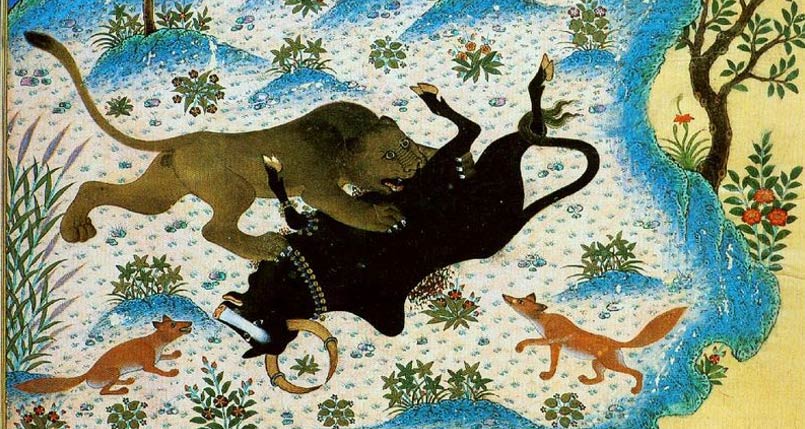What Pearls of Wisdom are Held in the Animal Tales of the Panchatantra?
The Panchatantra (which means the ‘Five Principles’ in Sanskrit) is a collection of interwoven short stories from India. The tales in the Panchatantra are told in both prose and poetry, and consist mainly of animal tales. This has led some scholars to note similarities between this collection of stories and Aesop’s fables. The Panchatantra is recorded to have migrated westwards into Persia, Arabia, and thence into Europe. In addition, these tales were also transmitted northwards into Tibet and China, as well as eastwards into Southeast Asia.
Teaching Important Lessons
It has been proposed that the Panchatantra was composed during the 3rd century BC by an Indian scholar and author by the name of Vishnu Sharma. Nevertheless, the tales were probably transmitted orally at first, and hence date to an earlier period of Indian history. These stories may have been first told by villagers as they gathered around campfires after a day’s work. The tales also contained valuable lessons, and served not only as light entertainment but also as a tool for teaching.
- Tracing Indo-Cambodian relations through Magnificent Stupa Architecture
- Incredible Megaliths of India: Star Maps and Headless Goddesses – Part I

A 'Panchatantra' relief at the Mendut temple, Central Java, Indonesia. (CC BY-SA 3.0)
Panchatantra can be translated literally as ‘Five Principles’, and was once used to teach princes the principles of Raja Niti (meaning ‘political science’) that they would find useful when they come to power. The Panchatantra is organized according to these five principles, which are Mitra Bhedha, Mitra Laabha, Suhrudbheda, Vigraha and Sandhi. These have been translated as ‘The Loss of Friends’, ‘Gaining Friends’, ‘Causing Dissension between Friends’, ‘Separation’, and ‘Union’ respectively.
Whilst it is generally accepted that the stories of the Panchatantra were meant to instill moral values in its readers, others have argued that these tales are in fact promoting worldly wisdom, including political shrewdness and pragmatism in worldly affairs. This argument finds support in the first section of the Panchatantra, where the reader is introduced to the brothers Karataka and Damanaka, two jackals in the retinue of a lion king. The former’s name means ‘Horribly Howling’, whilst the latter’s ‘Victor’. Of the two, Karataka is depicted as a noble character, whilst Damanaka a cunning one. At the end of this section, it is Damanaka, rather than Karataka who emerges victorious.

A page from Kelileh o Demneh dated 1429, from Herat, a Persian translation of the Panchatantra derived from the Arabic version – Kalila wa Dimna – depicts the manipulative jackal-vizier, Dimna, trying to lead his lion-king into war. (Public Domain)
Chickens and Pots
Although many of the stories in the Panchatantra are about animals, there are also tales about humans in this collection. One of them, for example, is known as ‘The Broken Pot’, in which a Brahmin dreams about all the wonderful things that he could get with the excess rice gruel that he had acquired. As the title of the story suggests, the Brahmin ends up breaking the pot accidentally, and with it, his fantastic dream. It may be apt to say that this is the Indian version of the English proverb “Do not count your chickens before they hatch”.

Illustration from Joseph Jacob’s Indian Fairy Tales, Panchatantra. (Dreamrly)
Spreading the Stories
From India, the Panchatantra travelled to the west into Persia. In the Shahnameh (the ‘Book of Kings’, which is Persia’s national epic), it is stated that the Panchatantra arrived in Persia around 570 AD, during the reign of the Sassanian king Khosrow I. It was the king’s physician, Borzuya, who translated the Panchatantra from Sanskrit to Middle Persian. Whilst Borzuya’s translation of the Panchatantra, as well as the original Sanskrit text are now lost, a translation of the former was made into Arabic by the translator Ibn al-Muqaffa’.
- The Extensive and Sometimes Mythical History of the Chola Empire
- The Quest for the Mythical Submerged Temples of Mahabalipuram
This piece of work was entitled Kalīla wa Dimma (‘Kalila and Dimna’), which is a reference to the first section of the Panchatantra. The name of the two jackals had changed from Karataka and Damanaka to Kalila and Dimma over the course of time, and whilst being translated from one language to another.

The Book of Panchatantra (Dreamrly)
Subsequently, the stories entered Europe via Greece (towards the end of the 11th century AD) and Spain (during the middle of the 13th century AD). It has been stated that the Panchatantra was translated into English as early as 1570, under the title The Morall Philosophie of Doni, and that in the century leading up to 1888, at least 20 different English translations had been made. This is evidence of the Panchatantra’s popularity, and it continues to hold modern interest today.
Featured image: From the same 1429 Persian manuscript. Sañjīvaka/Schanzabeh. Photo source: Public Domain
By Ḏḥwty
References
Ashliman, D.L. (ed.), 2014. The Panchatantra: a selection of tales from ancient India. [Online]
Available at: http://www.pitt.edu/~dash/panchatantra.html
Bedekar, V., 2008. History of Migration of Panchatantra and What It Can Teach Us. [Online]
Available at: http://www.orientalthane.com/speeches/speech2008.htm
Cultural India, 2017. Panchatantra Tales. [Online]
Available at: http://www.culturalindia.net/indian-folktales/panchatantra-tales/
New World Encyclopedia, 2015. Panchatantra. [Online]
Available at: http://www.newworldencyclopedia.org/entry/Panchatantra
Tales Of Panchatantra, 2016. Complete Works of Panchatantra in English. [Online]
Available at: http://www.talesofpanchatantra.com/works/complete
Tales Of Panchatantra, 2016. Panchatantra. [Online]
Available at: http://www.talesofpanchatantra.com/



















